Introduction
Imagine stepping into a home that instantly washes away the stress of the day. Sunlight filters through lush, green leaves, the air smells fresh and clean, and every piece of furniture tells a story of sustainability and thoughtful design. This isn’t just a fantasy; it’s the powerful reality of embracing Green House Decor. In our fast-paced, modern world, our homes have become more than just shelters; they are our sanctuaries. The way we design and decorate them has a profound impact on our well-being, our mindset, and our planet’s health. Green House Decor is the transformative philosophy of creating beautiful, functional, and harmonious living spaces by integrating nature, eco-conscious choices, and biophilic design principles.
It’s about moving beyond fleeting trends to cultivate a home that nurtures your soul while minimizing your environmental footprint. This comprehensive guide will walk you through every step of your journey, from understanding the core principles to implementing stunning, planet-friendly designs in every corner of your home. Get ready to transform your living space into a serene, sustainable, and stylish cozy nest with the ultimate guide to Green House Decor.
What is Green House Decor? Beyond Just a Trend
At its core, Green House Decor is an holistic approach to interior design that prioritizes environmental responsibility and human wellness. It’s a conscious movement that goes far beyond simply placing a few potted plants in a room. It’s about creating a symbiotic relationship between your indoor environment and the natural world outside.
The Three Pillars of Green House Decor
To truly understand this concept, we must break it down into its three fundamental pillars:
1. Sustainability and Eco-Consciousness
This pillar focuses on the origin, production, and lifecycle of every item in your home. It involves:
- Sustainable Materials: Choosing renewable, recycled, or upcycled materials like bamboo, reclaimed wood, cork, and organic cotton.
- Non-Toxic Finishes: Opting for zero-VOC (Volatile Organic Compounds) paints, natural waxes, and formaldehyde-free products to ensure superior indoor air quality.
- Ethical Production: Supporting brands and artisans who practice fair trade, ethical labor, and transparent, low-impact manufacturing processes.
- Durability and Longevity: Investing in high-quality, timeless pieces that won’t need to be replaced every few years, combating the culture of disposable furniture.
2. Biophilic Design: The Human-Nature Connection
Biophilia is the innate human tendency to connect with nature and other living systems. Biophilic design intentionally incorporates this connection into the built environment. Green House Decor leverages this through:
- Direct Nature Integration: This includes living plants, water features, natural sunlight, and fresh air.
- Indirect Nature Integration: Using colors, patterns, materials, and forms that evoke nature. Think wood grain textures, stone accents, a color palette of greens, browns, and blues, and organic, flowing shapes.
- Experience of Space and Place: Creating layouts that feel open and airy, with clear views to the outdoors and spaces that provide a sense of refuge and prospect.
3. Mindful Consumption and Circularity
A truly “green” home is also about what you don’t bring into it. This pillar emphasizes:
- Reducing Waste: Choosing minimal packaging, repairing instead of replacing, and avoiding single-use plastics.
- Upcycling and Repurposing: Breathing new life into old furniture or decor items, giving them a new purpose and story.
- Supporting the Circular Economy: Buying second-hand, vintage, or from companies that have take-back programs for their products.
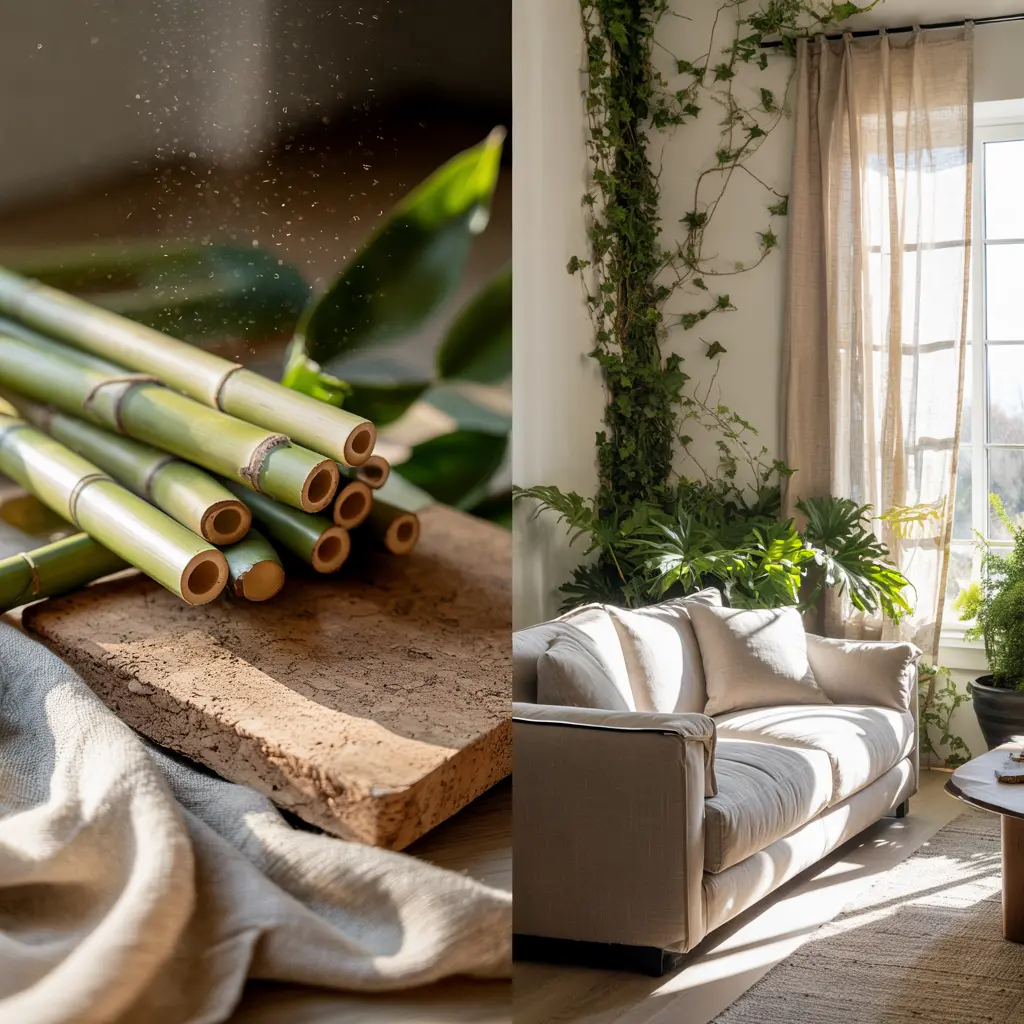
The Multifaceted Benefits of Embracing Green House Decor
Adopting a Green House Decor philosophy isn’t just an aesthetic choice; it’s an investment with returns for your health, your wallet, and the world around you.
Health and Well-being Benefits
The impact of a green home on your physical and mental health is profound and backed by science.
- Improved Air Quality: Plants are natural air purifiers. They absorb pollutants like formaldehyde, benzene, and trichloroethylene through their leaves and roots, a process famously documented by NASA’s Clean Air Study. Coupled with natural ventilation, this leads to cleaner, oxygen-rich air.
- Reduced Stress and Anxiety: Studies have consistently shown that exposure to nature, even in simulated forms, can lower cortisol levels (the stress hormone), reduce blood pressure, and decrease feelings of anxiety. A glance at a green plant after a long workday can be a powerful mental reset.
- Enhanced Focus and Creativity: Biophilic elements in workspaces and homes have been linked to improved concentration, cognitive function, and creative problem-solving abilities. A room with natural light and plants can be your ultimate productivity booster.
- Better Sleep: Incorporating certain plants like Lavender or Jasmine, and using materials that regulate humidity, can contribute to a more restful sleep environment. Furthermore, reducing exposure to synthetic off-gassing from furniture and paints can improve overall sleep quality.
Significant Environmental Impact
Your decor choices have a ripple effect on the global ecosystem.
- Reduced Carbon Footprint: By choosing locally sourced materials and products, you cut down on the emissions associated with long-distance transportation. Sustainable materials like bamboo also sequester carbon as they grow.
- Conservation of Resources: Using reclaimed wood saves trees. Choosing recycled metal and glass reduces the energy and raw materials needed for new production. Water-saving fixtures and drought-tolerant plants conserve precious water.
- Minimized Landfill Waste: By buying durable, repairable goods and embracing vintage finds, you directly combat the massive problem of furniture and decor ending up in landfills.
- Support for Biodiversity: Opting for organic textiles and supporting sustainable forestry practices helps protect ecosystems and the species that inhabit them.
Aesthetic and Financial Perks
Going green is also incredibly stylish and can be kind to your budget.
- Timeless Beauty: Nature-inspired design is never going out of style. Unlike fast-fashion decor, a well-crafted wooden table or a terracotta pot has an enduring, classic appeal that transcends temporary trends.
- Unique Character: Vintage, handmade, and upcycled items bring a unique soul and story to your home that mass-produced items simply cannot replicate. Your home becomes a personal gallery of meaningful finds.
- Increased Property Value: As awareness grows, homes with features like good natural light, energy efficiency, and healthy, non-toxic materials are becoming increasingly attractive to buyers, potentially boosting your home’s market value.
- Long-Term Savings: While the initial investment for some high-quality sustainable pieces might be higher, their durability means you save money in the long run. Energy-efficient lighting and appliances also lead to lower utility bills.
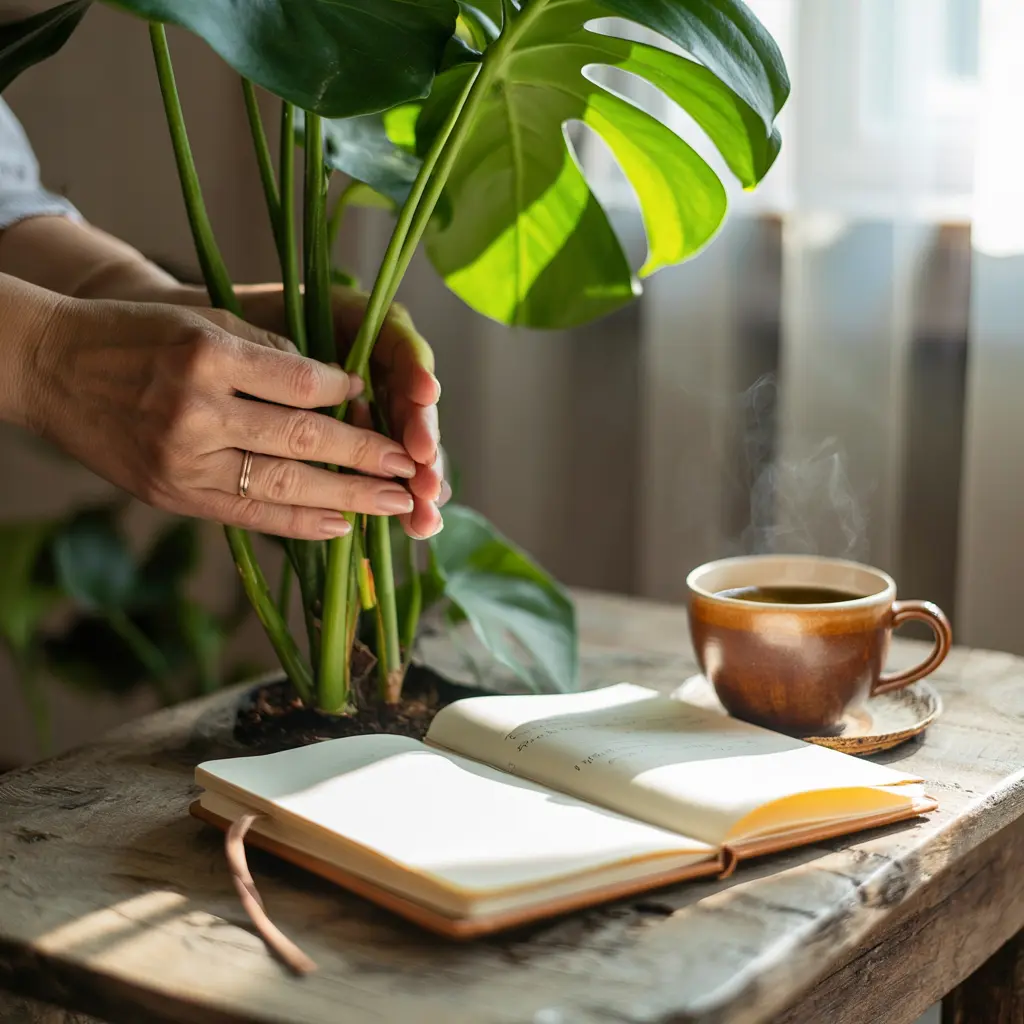
Exploring the Styles: Green House Decor for Every Aesthetic
One of the greatest strengths of Green House Decor is its incredible versatility. It can be adapted to fit any personal style, from the stark minimalist to the eclectic bohemian. For more inspiration, explore our Home Decor Ideas collection, which perfectly complements sustainable design.
Modern Minimalist Green
This style marries the “less is more” philosophy with natural elements. The focus is on clean lines, open space, and a curated selection of decor.
- Color Palette: Neutral foundations (whites, grays, beiges) punctuated by the vibrant green of plants.
- Materials: Sleek bamboo, polished concrete with recycled content, glass, and metallic accents.
- Plants: Structural and architectural plants like Snake Plants, ZZ Plants, or a single, stunning Fiddle Leaf Fig.
- Furniture: Simple, functional pieces made from sustainable sources. Think a platform bed of reclaimed teak or a sofa with a frame certified by the Forest Stewardship Council (FSC).
- Key Decor: A single, striking piece of art made from natural materials, minimalist terracotta pots, and smart, energy-efficient lighting.
Bohemian Jungle Oasis
For those who love a layered, textured, and personality-filled space, the Boho-Jungle style is perfect. It’s an abundant, “more is more” approach.
- Color Palette: Earthy tones (terracotta, mustard yellow, sage green) mixed with rich jewel tones.
- Materials: Macramé, rattan, wicker, raw-edge wood, and lots of textured textiles like wool rugs and organic cotton throws.
- Plants: An abundance of varied species! Think cascading Pothos, full-bodied Ferns, colorful Prayer Plants, and hanging Spider Plants.
- Furniture: Low-level seating, vintage finds, floor cushions, and rattan peacock chairs.
- Key Decor: A gallery wall of botanical prints, layered rugs, mismatched vintage pots, and beaded light fixtures.
Scandinavian Green Hygge
This style is all about creating a warm, cozy, and inviting sanctuary, especially perfect for colder climates. It emphasizes comfort and natural light.
- Color Palette: Light and airy—think white walls, light wood floors, and soft gray textiles, with green plants providing the main color pop.
- Materials: Light-toned woods like pine and ash, wool, sheepskin, and ceramic.
- Plants: Hardy, green plants that thrive in indirect light, such as Philodendrons, Peace Lilies, and Swiss Cheese Plants.
- Furniture: Functional, elegant, and timeless designs from sustainable Nordic brands. Plush sofas and armchairs with natural fiber cushions.
- Key Decor: Plenty of candles (soy or beeswax), chunky knit throws, and simple, functional pottery.
Industrial Organic
This style softens the raw, edgy feel of industrial design with the warmth of nature. It’s a perfect blend of toughness and tenderness.
- Color Palette: A base of grays, blacks, and metals, balanced with warm wood tones and vibrant green foliage.
- Materials: Reclaimed wood, exposed brick, black steel, and concrete.
- Plants: Large, statement plants that can hold their own in a strong architectural space, like Olive Trees, Rubber Plants, or large Birds of Paradise.
- Furniture: Repurposed factory trolleys as coffee tables, dining tables with metal bases and wooden tops, and leather sofas (look for vegetable-tanned options).
- Key Decor: Edison bulb lighting, wire basket planters, and open shelving made from reclaimed scaffolding.
Coastal Natural
Inspired by the beach, this style uses a palette of blues, whites, and sands to create a relaxed, airy atmosphere.
- Color Palette: Whites, creams, beiges, and soft blues and greens.
- Materials: Driftwood, jute, seagrass, linen, and washed-out woods.
- Plants: Air plants (Tillandsia), succulents, and palms that evoke a tropical, beachy feel.
- Furniture: Slipcovered sofas in natural linen, woven headboards, and light wood coffee tables.
- Key Decor: Shell collections, nautical rope details, glass jars filled with sand and shells, and striped patterns in organic cotton.
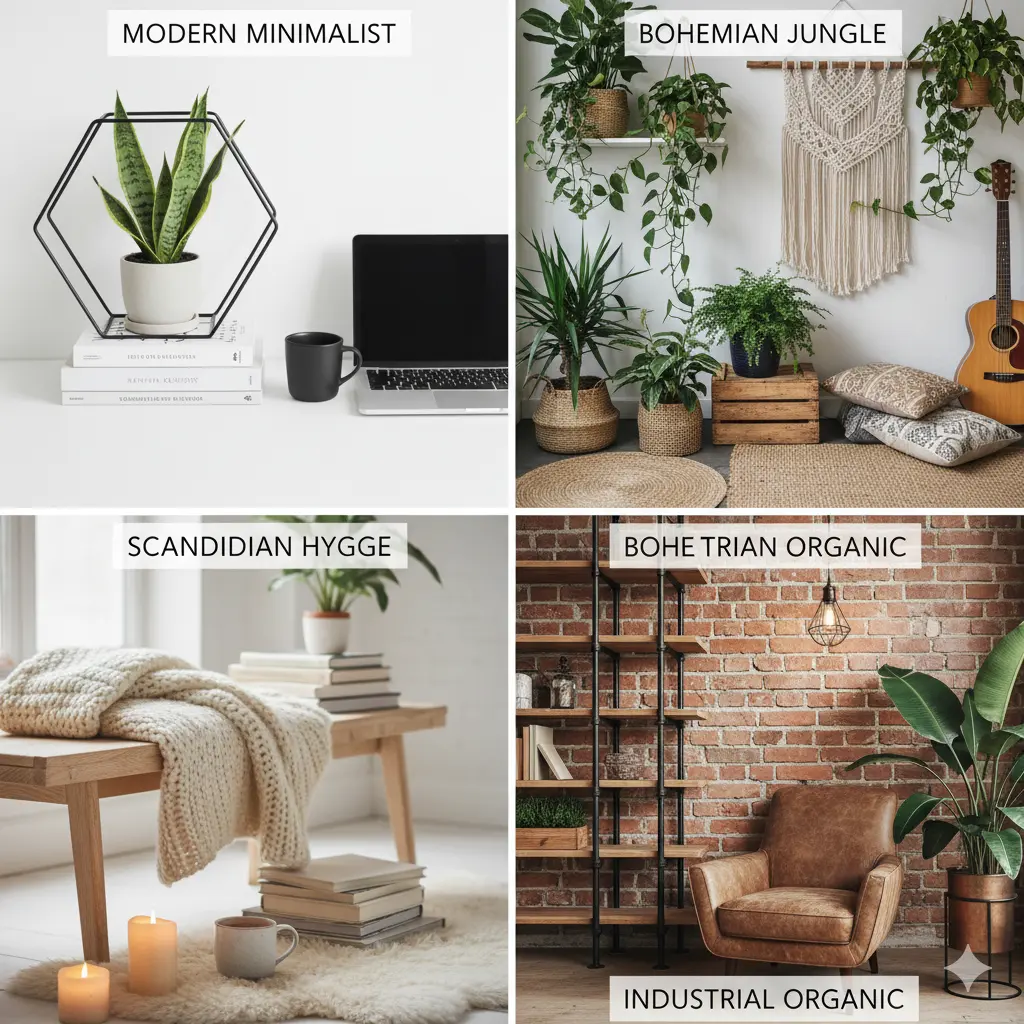
The Green House Decor Toolkit: Plants, Furniture & Accessories
Now, let’s get into the specifics. What exactly do you need to bring your Green House Decor vision to life?
The Best Plants for Green House Decor (By Room and Light)
Choosing the right plant for the right place is key to a thriving green home.
For Low-Light Areas (North-facing rooms, bathrooms, hallways):
- Snake Plant (Sansevieria): The ultimate survivor. Purifies air and thrives on neglect.
- ZZ Plant (Zamioculcas zamiifolia): Glossy, beautiful, and incredibly drought-tolerant.
- Pothos (Epipremnum aureum): A fast-growing trailing plant that’s perfect for shelves and hanging baskets.
- Peace Lily (Spathiphyllum): Prefers shade and will even tell you when it needs water by drooping. Excellent air purifier.
For Bright, Indirect Light (East or West-facing windows):
- Fiddle Leaf Fig (Ficus lyrata): The iconic statement plant. Requires consistent care but is worth the effort.
- Monstera Deliciosa: With its beautiful, split leaves, it adds a dramatic, tropical touch.
- Spider Plant (Chlorophytum comosum): A prolific grower that produces “pups,” perfect for propagating and sharing.
- Rubber Plant (Ficus elastica): Has large, glossy leaves in stunning dark green or burgundy shades.
For Air Purification (NASA Study Stars):
- Areca Palm: A natural humidifier and air purifier.
- Lady Palm: Effective at removing ammonia.
- Boston Fern: A classic fern that’s great at removing formaldehyde.
- English Ivy: Particularly good at reducing airborne mold.
Sustainable Furniture Choices
Your big-ticket items should reflect your green values.
- Material Matters:
- Reclaimed Wood: Full of character and history, each piece is unique. Used for dining tables, shelving, and bed frames.
- Bamboo: A rapidly renewable grass that’s incredibly strong and versatile. Ideal for flooring, cutting boards, and furniture.
- Rattan & Wicker: Natural, renewable, and adds wonderful texture.
- Cork: Harvested from the bark of the cork oak tree without cutting it down. Used for flooring, pinboards, and even furniture.
- Organic Textiles: Look for GOTS (Global Organic Textile Standard) certified organic cotton, linen, and hemp for upholstery, curtains, and bedding.
- Certifications to Look For:
- FSC (Forest Stewardship Council): Ensures wood comes from responsibly managed forests.
- Greenguard Gold: certifies that products have low chemical emissions, improving indoor air quality.
- Cradle to Cradle: A rigorous standard for safe, circular, and responsible products.
Eco-Conscious Accessories & Textiles
The details make the home.
- Textiles: Choose organic cotton, linen, wool, or Tencel™ lyocell for curtains, rugs, throw pillows, and bedding. Look for natural dyes.
- Lighting: Switch to LED bulbs. Choose lamps made from sustainable materials like ceramic, wood, or recycled glass.
- Decor Accents:
- Pottery: Hand-thrown terracotta, ceramic, or stoneware planters.
- Art: Support local artists who use natural materials or create botanical prints.
- Vases & Candle Holders: Made from recycled glass, reclaimed wood, or natural stone.
- Rugs: Jute, sisal, seagrass, and wool rugs are all natural, biodegradable options.
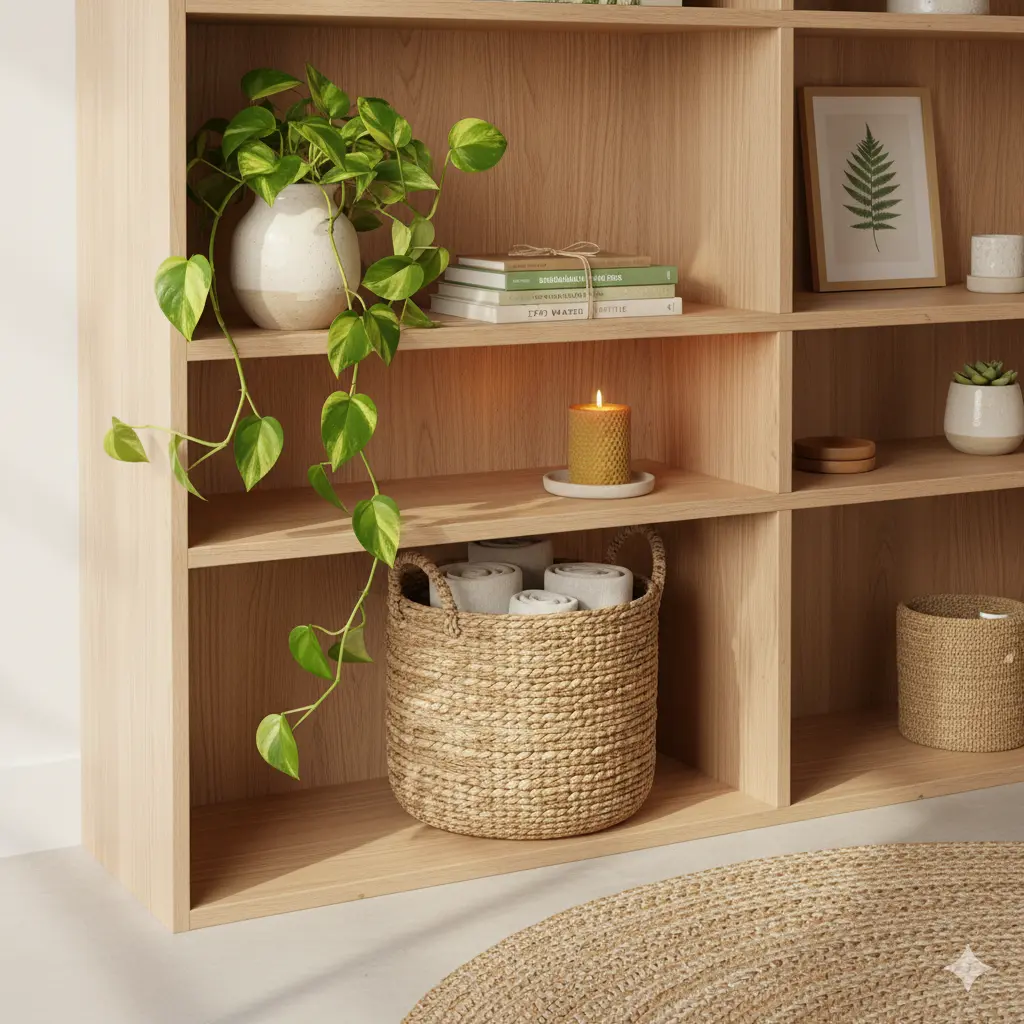
DIY Green House Decor: Personalize Your Space Sustainably
There’s no better way to create a unique and personal Green House Decor space than by rolling up your sleeves and creating it yourself. DIY projects reduce waste, save money, and infuse your home with character.
Macramé Plant Hangers
A classic boho-chic project that’s easy to learn.
- Materials: 100% cotton cord (avoid synthetic ropes), a wooden ring, and scissors.
- Benefits: Elevates plants, saves floor space, and adds beautiful texture to your walls.
- SEO Tip: Search for “easy macrame plant hanger tutorial for beginners” to find visual guides.
Upcycled Furniture Makeovers
Give an old, tired piece of furniture a new lease on life.
- The Process: Find a solid wood piece from a thrift store or your attic. Sand it down, and refinish it with a non-toxic, plant-based paint or a natural oil finish (like linseed or tung oil).
- Benefits: Prevents waste, saves money, and creates a one-of-a-kind item.
- Idea: Transform an old wooden ladder into a rustic blanket holder or a set of shelves.
Propagating and Sharing Plants
This is the ultimate Green House Decor hack—it’s free!
- How-to: Many common houseplants like Pothos, Spider Plants, and Snake Plants can be easily propagated in water from cuttings or pups.
- Benefits: Fill your home with more plants for free, and share the green love with friends and family, fostering a community of plant lovers.
- Display: Place your propagation stations in beautiful, upcycled glass bottles or jars on a windowsill.
Natural Decor Crafts
- Pressed Flower Art: Collect fallen leaves and flowers, press them in a book, and frame them in a second-hand frame for beautiful, natural art.
- Terrariums: Create a self-contained ecosystem in a glass jar. Perfect for small spaces and a fascinating decor piece.
- Painted Terracotta Pots: Use leftover non-toxic paint to add patterns and personality to simple terracotta pots.
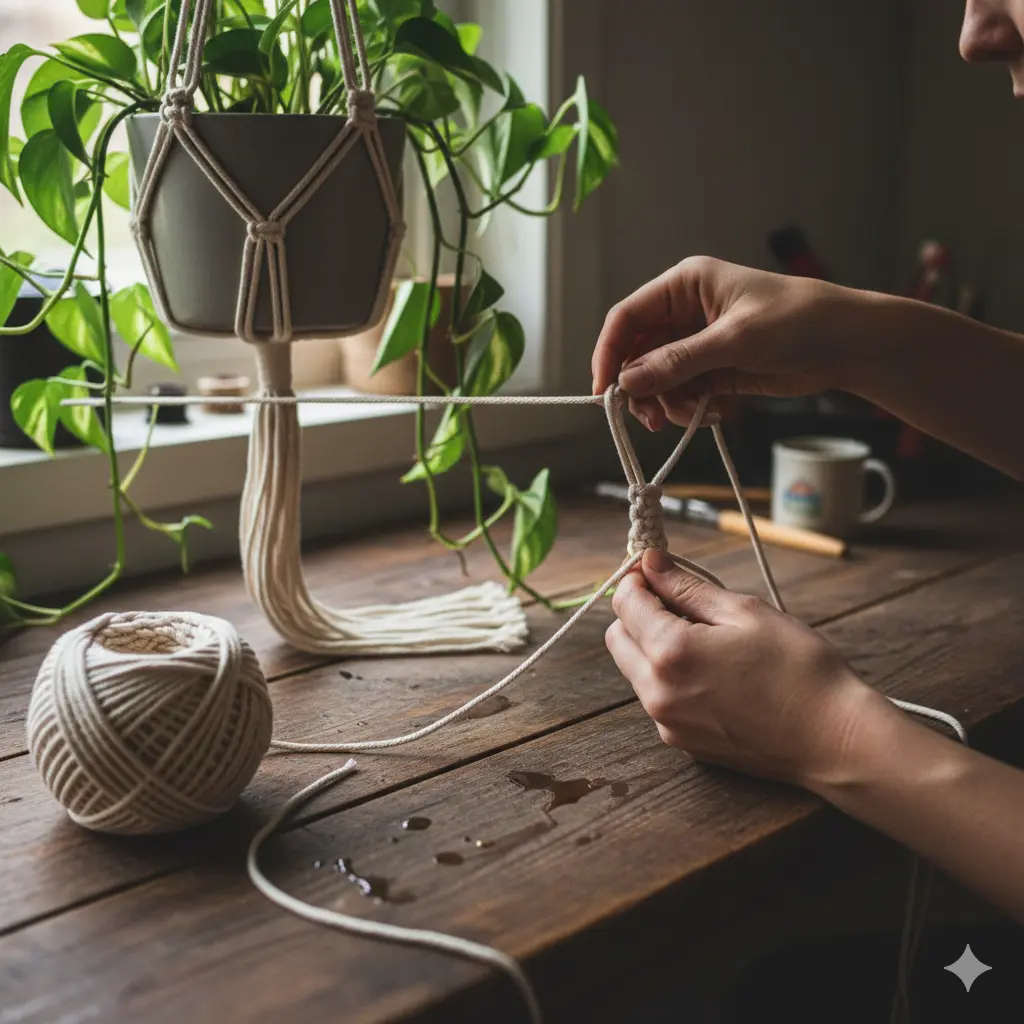
Budget-Friendly vs. Luxury Green House Decor
Creating a sustainable home is accessible to every budget. The philosophy remains the same; the execution varies.
The Thrifty Green Decorator
- Source Second-Hand: Thrift stores, flea markets, and online marketplaces (Facebook Marketplace, Craigslist) are treasure troves for solid wood furniture, unique pots, and decor. The ultimate form of recycling!
- Propagate and Swap: As mentioned, grow your plant collection for free. Organize plant-swap events with friends.
- DIY Everything: From painting walls to sewing pillow covers, doing it yourself saves on labor costs and allows you to control the materials used.
- Focus on Small Changes: Start by swapping out your lighting to LEDs, adding a few air-purifying plants, and switching to organic bedding one piece at a time.
- Natural Finds: Collect interesting branches, stones, or seashells from nature (responsibly and where permitted) to use as decor.
The High-End Green Investor
- Commissioned Pieces: Work with a local woodworker to create a custom dining table from a single slab of reclaimed wood or with a ceramic artist for a unique sink.
- Investment Furniture: Purchase heirloom-quality pieces from renowned sustainable brands like Medley, Savvy Rest, or Cisco Home, which are built to last for generations.
- Smart Home Integration: Invest in a fully integrated smart home system that optimizes energy use, controlling lighting, heating, and irrigation for your indoor plants with maximum efficiency.
- Architectural Integration: Work with an architect to incorporate passive solar design, a living green wall, or a skylight into your home’s structure.
- Organic Art: Invest in original art from artists who specialize in using natural, sustainable materials.
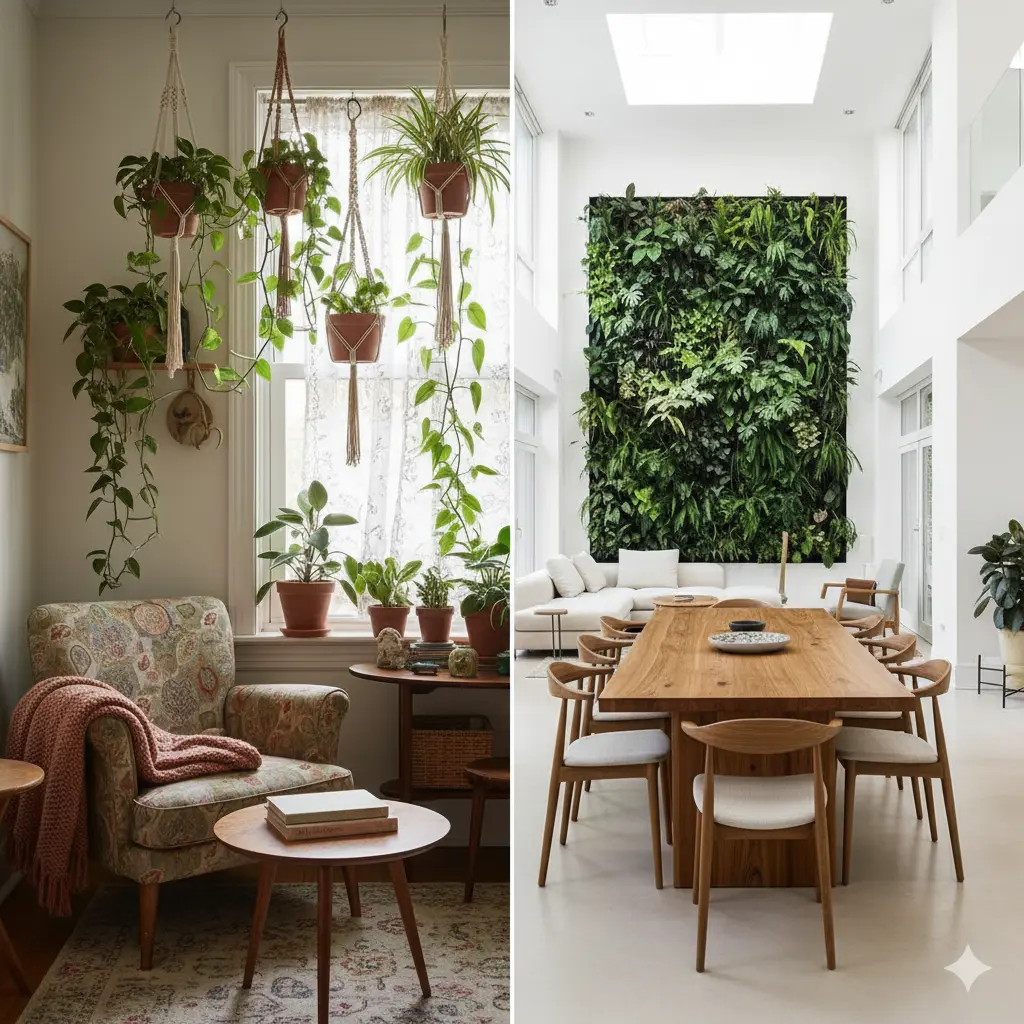
Room-by-Room Guide to Green House Decor
Let’s break down the principles of Green House Decor and apply them to every specific room in your house.
Living Room Green House Decor: The Heart of the Home
The living room is where we relax and entertain. It should be inviting, comfortable, and reflective of your personal style.
- Focal Point: Create a “green focal point” with a large statement plant like a Fiddle Leaf Fig or a Bird of Paradise in a beautiful, sustainable planter.
- Seating: Choose a sofa with an FSC-certified wood frame and cushions filled with natural latex or recycled materials. Upholster in organic cotton or hemp.
- Textiles: Layer texture with a jute or wool rug, organic cotton throw pillows, and a chunky knit blanket.
- Air Quality: Cluster several air-purifying plants like Areca Palms, Peace Lilies, and Snake Plants together for maximum impact.
- Lighting: Maximize natural light. Use sheer, linen curtains. For the evening, use warm-toned LED bulbs in lamps made from natural materials.
- Accessories: Use a reclaimed wood tray on your coffee table, display books on sustainability, and choose art that features natural landscapes.
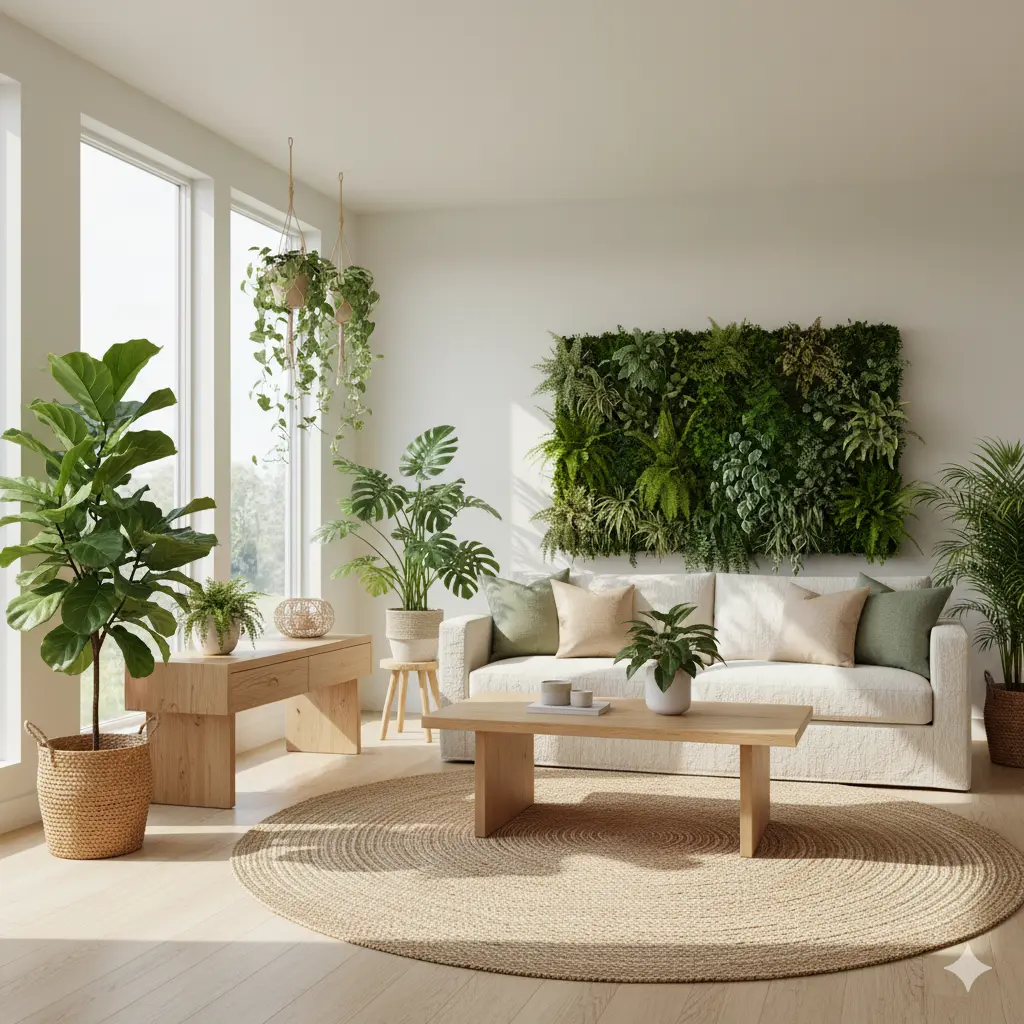
Kitchen Green House Decor: The Nourishing Hub
The kitchen is a space of creation and nourishment. Green House Decor here focuses on non-toxic surfaces, waste reduction, and fresh herbs.
- Countertop Herbs: Grow a small indoor herb garden on your windowsill. Rosemary, thyme, mint, and basil are practical and beautiful.
- Materials: If renovating, consider countertops made from recycled glass, paper composite, or sustainable bamboo. For existing kitchens, focus on accessories.
- Sustainable Storage: Use glass jars for storing dry goods, bamboo fiber containers for leftovers, and reusable beeswax wraps instead of plastic wrap.
- Textiles: Use organic cotton dish towels and a natural fiber (jute or coir) kitchen mat.
- Plants: Aloe Vera (useful for burns!) and Spider Plants do well in kitchen environments. A trailing Pothos on a high shelf adds a lovely touch.
- Waste Station: Have a clearly labeled and attractive composting and recycling system to make sustainable practices effortless.
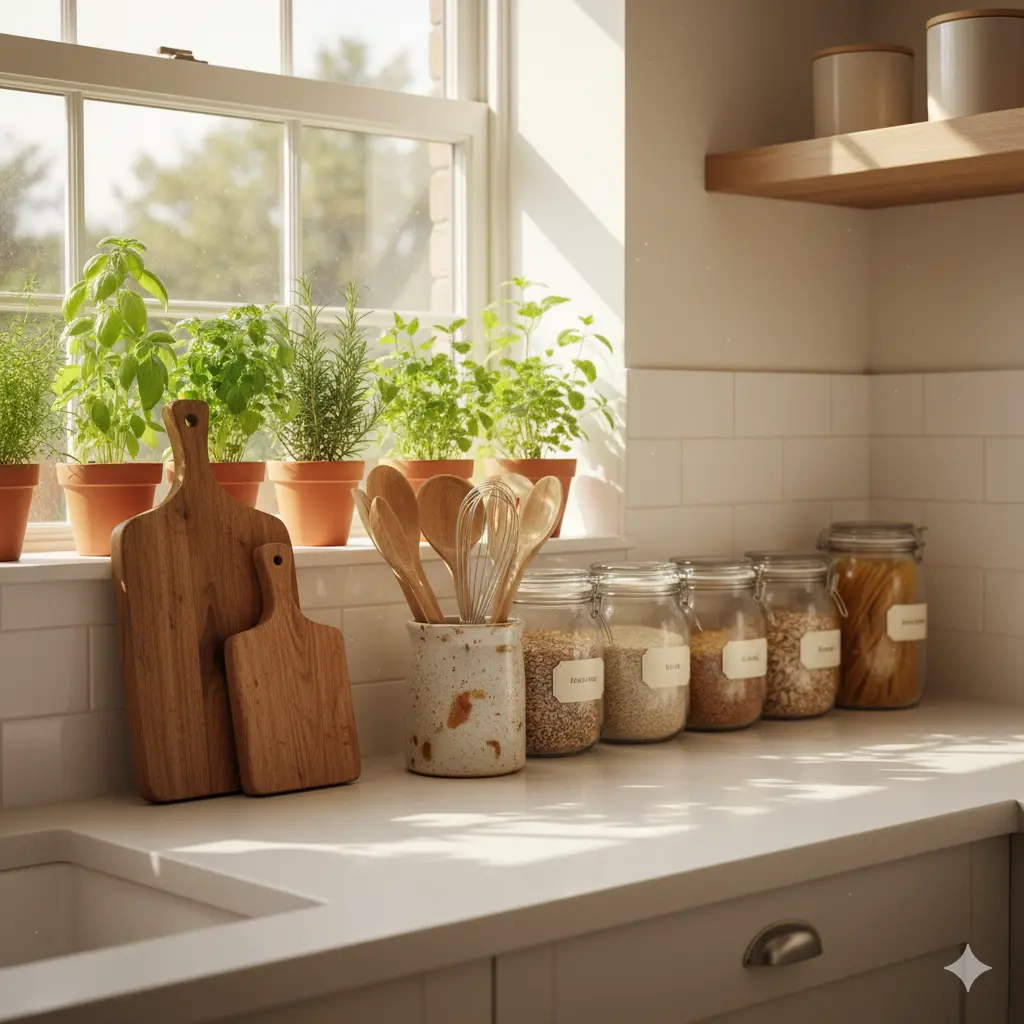
Bedroom Green House Decor: The Ultimate Sanctuary
Your bedroom should be a temple of rest and rejuvenation. The goal is serenity and the purest air quality.
- The Bed: This is your most important investment. Opt for an organic mattress made from natural latex, organic cotton, and wool. The bed frame should be solid, untreated wood or bamboo.
- Bedding: Choose GOTS-certified organic cotton, linen, or hemp sheets, duvet covers, and pillowcases. These are breathable and free from pesticide residues.
- Air-Purifying Powerhouses: Place several of the best air-purifying plants in your bedroom. Snake Plants and Peace Lilies are excellent choices. Note: It’s a myth that plants in the bedroom are harmful; they release minimal CO2 at night, which is negligible.
- Lighting: Use blackout curtains made from organic fabric to ensure complete darkness. Have dimmable, warm LED lights for a calming evening routine.
- A Calming Palette: Stick to soft, earthy, or neutral colors on the walls and in your textiles to promote a sense of peace.
- Clutter-Free: Use natural storage solutions like woven baskets and wooden boxes to keep clutter at bay, contributing to a restful mind.
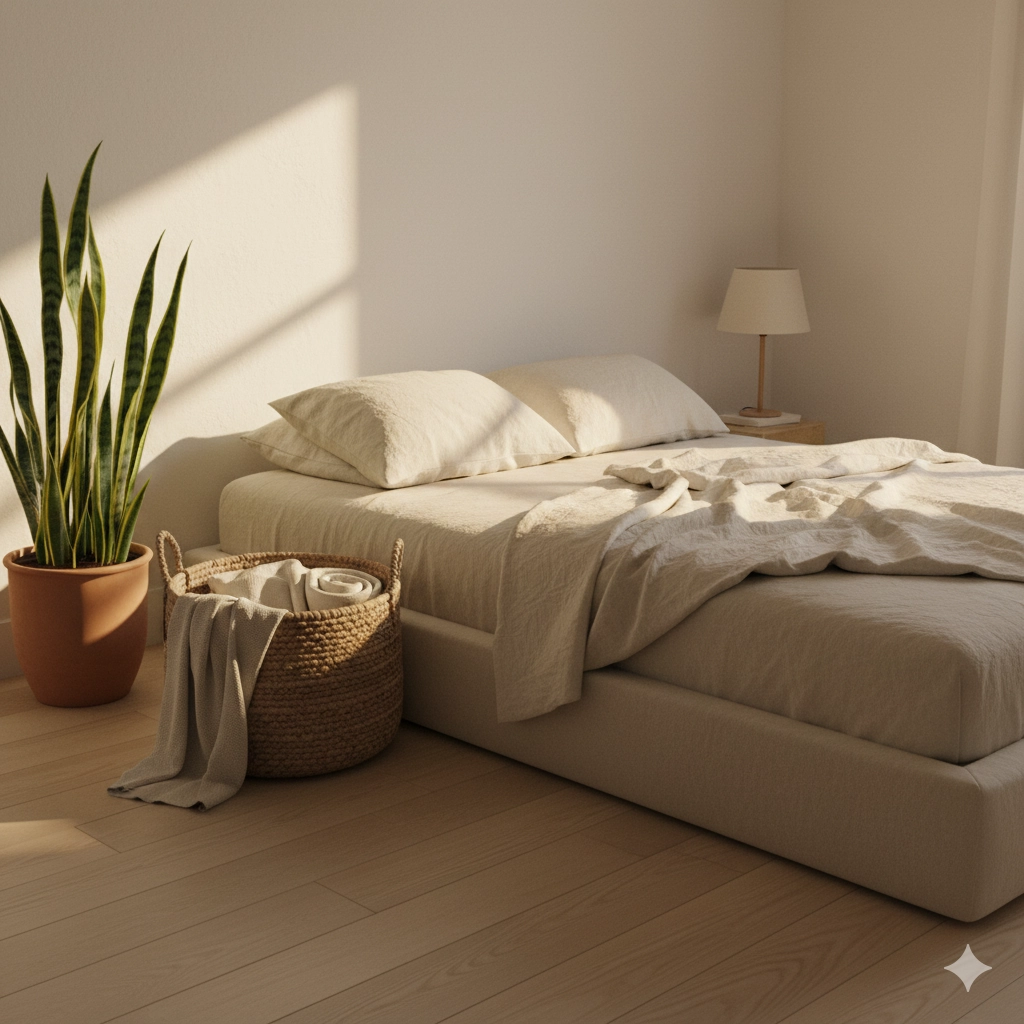
Bathroom Green House Decor: A Spa-Like Retreat
Transform your bathroom from a utilitarian space into a lush, spa-like oasis. The key here is choosing plants that thrive in humidity and low light.
- Humidity-Loving Plants: This is the perfect environment for ferns, Peace Lilies, Spider Plants, and even Orchids. They will flourish in the steam from your shower.
- Natural Materials: Use a teak or bamboo bath mat, which is naturally water-resistant and mold-resistant. Use organic cotton towels.
- Non-Toxic Cleaners: Display your natural, plant-based cleaning products in beautiful glass bottles. This is both aesthetic and functional.
- Bath Products: Choose soaps, shampoos, and lotions packaged in glass, metal, or that are refillable, to reduce plastic waste.
- Accessories: A simple wooden stool, a ceramic soap dispenser, and a small vase with a single flower can elevate the space.
- Lighting: If possible, maximize natural light. Otherwise, use LEDs with a high CRI (Color Rendering Index) for applying makeup or shaving.
Where to place in blog: At the start of the “Bathroom Green House Decor” section.
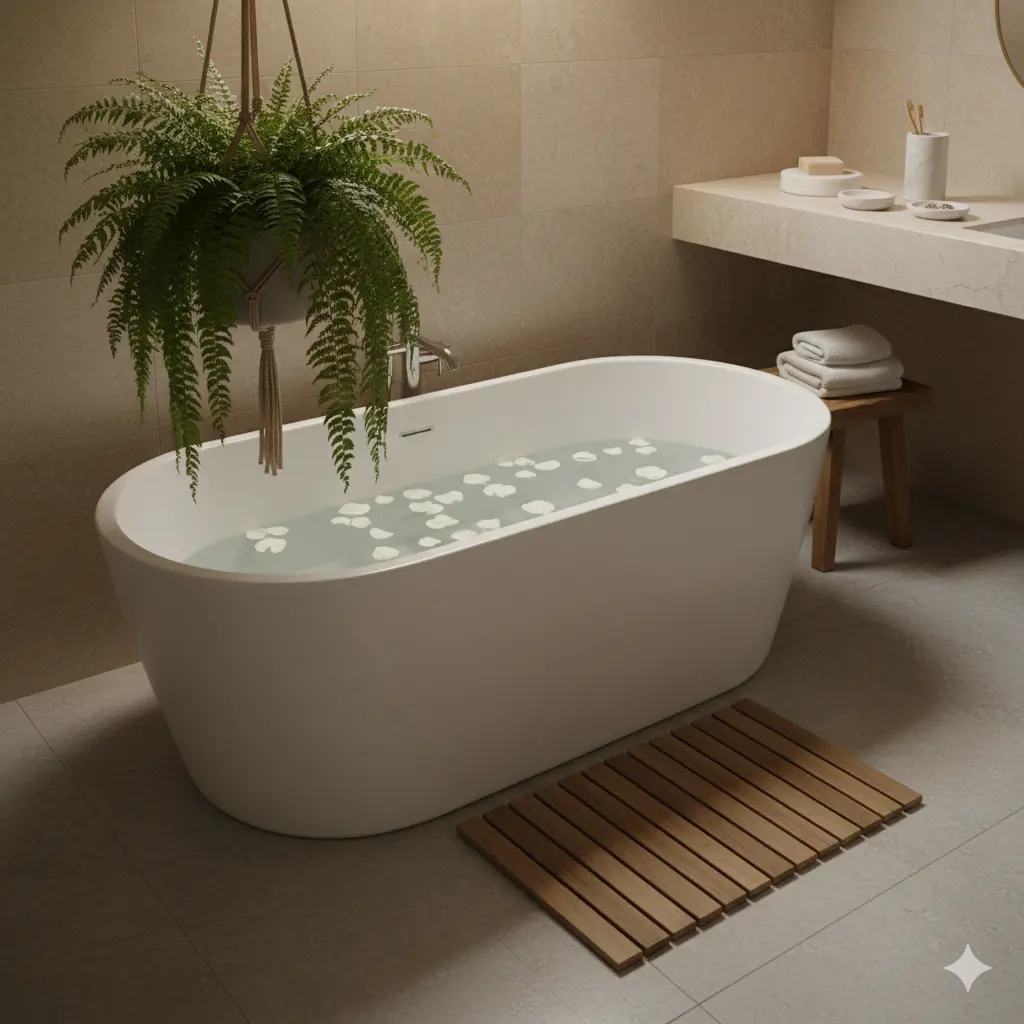
Home Office Green House Decor: Boost Productivity
A green home office can significantly reduce work-related stress and improve your focus and output.
- Desk Plants for Focus: Studies show that having a plant on your desk can improve concentration. A small Snake Plant, a succulent, or a ZZ Plant are low-maintenance options.
- The Right Chair & Desk: Invest in an ergonomic chair with non-toxic finishes and a desk made from reclaimed or FSC-certified wood.
- Natural Light: Position your desk to take advantage of natural light to reduce eye strain. Use task lighting with a warm LED bulb for the evenings.
- Organization: Use desk organizers made from bamboo or recycled cardboard. Keep cables tidy with natural fiber cord wraps.
- View: If possible, position your desk to have a view of a larger plant or even a window looking outside to give your eyes a rest.
- Air Circulation: Ensure good air flow. An open window, a small fan, and air-purifying plants will keep the air fresh and your mind alert.
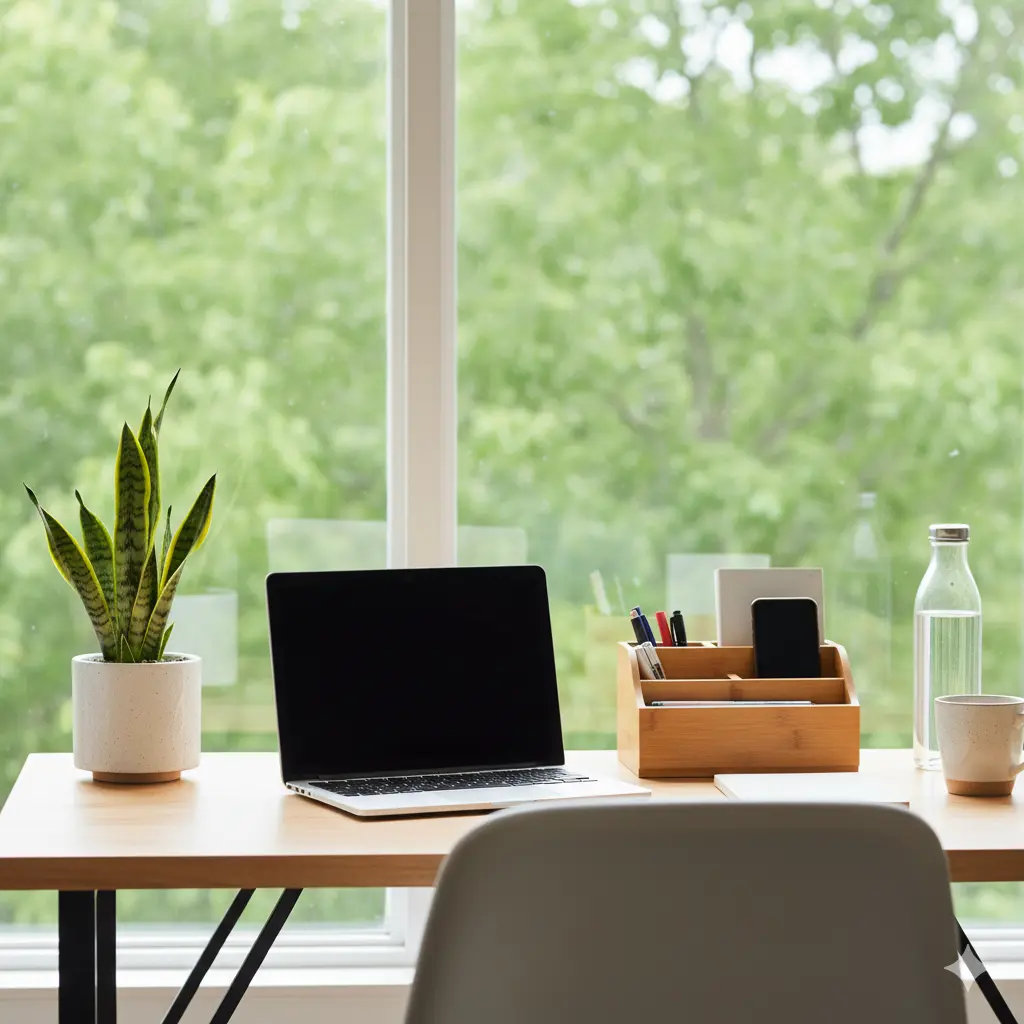
Balcony & Patio Green House Decor: Extending Outdoors
Don’t neglect your outdoor spaces. They are a crucial part of the green ecosystem.
- Container Gardening: Even a small balcony can host a container garden. Grow flowers, herbs, and even small vegetables in pots made from recycled plastic, terracotta, or wood.
- Furniture: Choose outdoor furniture made from recycled plastic, FSC-certified teak, or sustainably sourced eucalyptus.
- Create a Habitat: Choose native plants and flowers to attract and support local pollinators like bees and butterflies.
- Privacy: Use a trellis with climbing plants like Jasmine or Clematis to create a natural, living privacy screen.
- Lighting: Use solar-powered string lights or lanterns to create a magical evening ambiance without using any electricity.
- Water Feature: A small, solar-powered fountain can provide the soothing sound of water and attract birds.
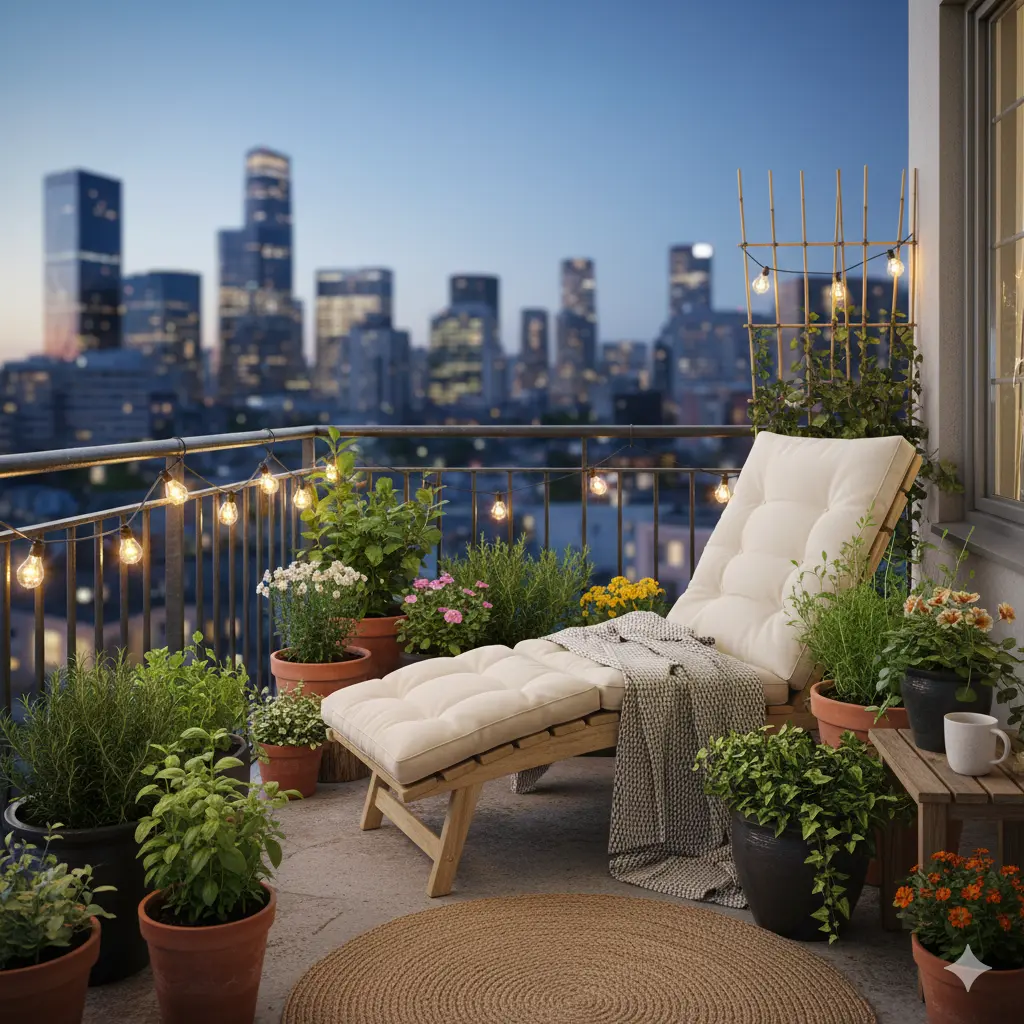
Seasonal Green House Decor: Refreshing Your Home All Year Round
A key part of living in tune with nature is acknowledging the changing seasons. Refreshing your Green House Decor throughout the year keeps your home feeling dynamic and connected to the outdoors.
Spring: A Time of Rebirth and Renewal
- Focus: Lightness, airiness, and new growth.
- Actions: Do a “spring cleaning” with natural cleaners. Re-pot plants that have outgrown their containers. Propagate new plants from cuttings. Introduce flowering plants like African Violets or Orchids. Swap out dark, heavy winter textiles for lighter linen or cotton throws and pillows in pastel shades. Open the windows wide to let in the fresh air!
Summer: Lush, Vibrant, and Airy
- Focus: Maximizing light and embracing abundance.
- Actions: Move some sun-loving plants (like succulents and cacti) to a sunny spot. Display fresh-cut flowers from your garden or the farmer’s market. Use sheer curtains to diffuse harsh sunlight. Incorporate cool colors like blues and greens. If you have a patio, treat it as an extra room and style it accordingly.
Autumn: Cozy, Warm, and Textured
- Focus: Creating warmth and comfort as the light fades.
- Actions: Bring any outdoor plants inside before the first frost. Swap light summer linens for chunky knit wool throws and velvet pillows in warm tones of orange, burgundy, and gold. Display natural autumn decor like pine cones, acorns, and dried wheat in a bowl. Introduce more ambient lighting with soy candles.
Winter: Hygge, Evergreens, and Stillness
- Focus: Creating a cozy, inward-looking sanctuary.
- Actions: Focus on evergreens like Norfolk Island Pines or small potted Christmas trees that can be planted outside later. Use LED fairy lights to create a warm, magical glow. The winter sun is weaker, so you may need to move plants closer to windows. This is the time for maximum hygge—think plush rugs, hot tea, and enjoying your green indoor oasis while it’s cold outside.
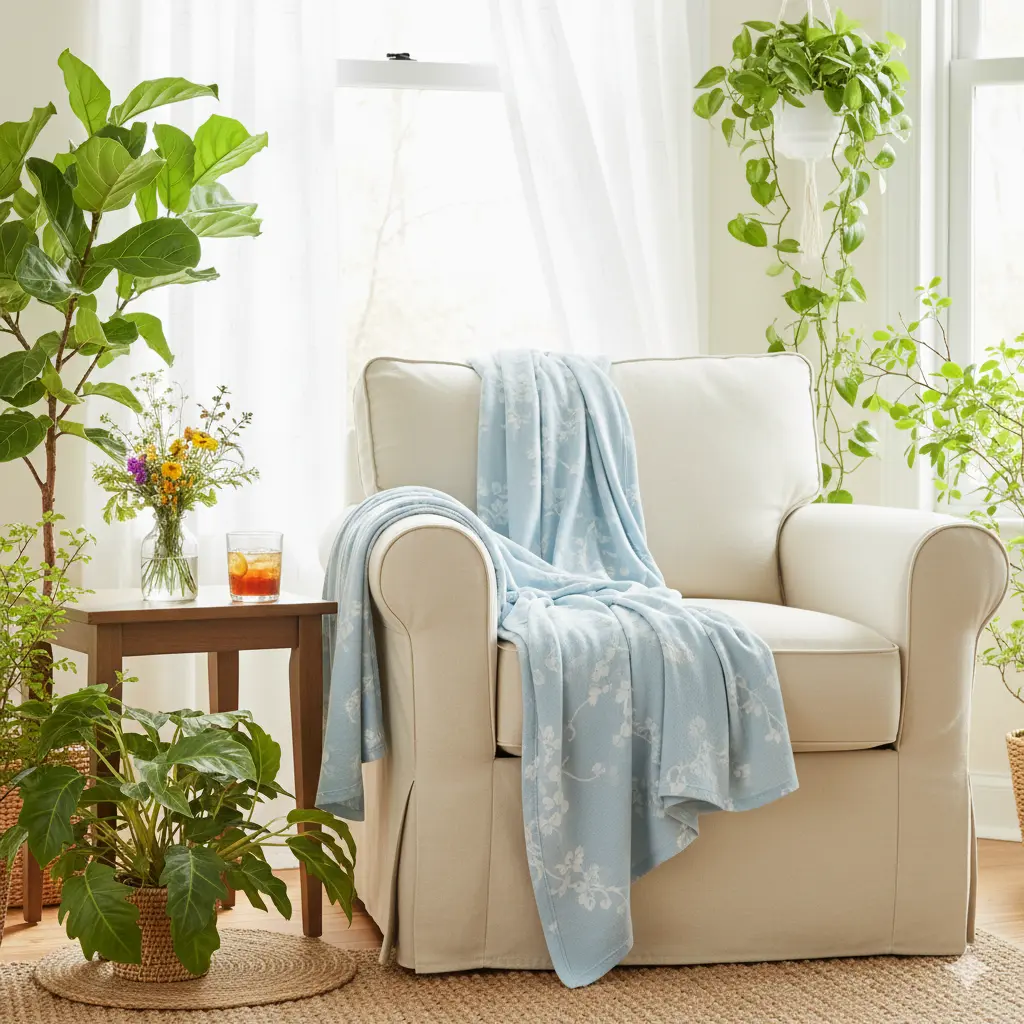
Common Green House Decor Mistakes to Avoid
Even with the best intentions, it’s easy to stumble. Here’s how to avoid common pitfalls on your Green House Decor journey.
- Overwatering Your Plants: The #1 killer of houseplants. Always check the soil moisture before watering. When in doubt, it’s better to underwater.
- Ignoring Light Conditions: Placing a sun-loving plant in a dark corner, or a shade plant in direct sun, is a recipe for disaster. Research each plant’s needs.
- Greenwashing: Falling for marketing terms like “natural” or “eco” without checking for certifications (FSC, GOTS, Greenguard). Always do your research on brands.
- Toxic Triumvirate: Using conventional paint, synthetic rugs, and particleboard furniture that off-gas VOCs, negating the air-purifying benefits of your plants.
- Impulse Buying Decor: Buying cheap, fast-fashion decor items that you don’t love and will throw away in a year. Embrace a “less is more” mentality and buy only what you truly need and adore.
- Neglecting Plant Care: Plants are living things. Forgetting to dust their leaves (which blocks light), not fertilizing them occasionally, or leaving them root-bound will lead to an unhealthy-looking green space.
- Trying to Do Everything at Once: Green House Decor is a journey, not a destination. Don’t feel pressured to overhaul your entire home in one weekend. Start small, one room or one habit at a time.
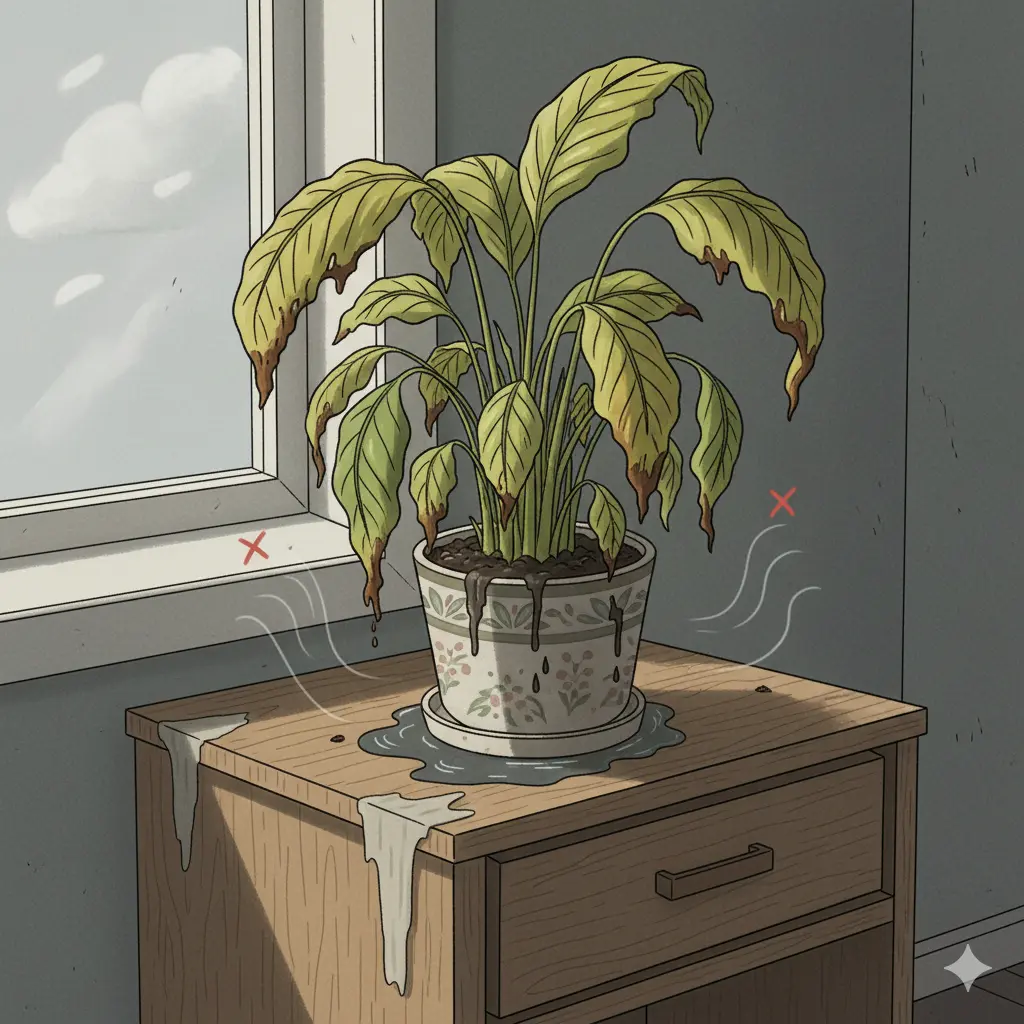
Expert Tips and The Future of Green House Decor (2025 and Beyond)
To give you a leading edge, here are some insights from the forefront of sustainable design.
Pro Tips for a Flawless Green Home
- The Rule of Thirds: When styling a shelf or mantel, use a ratio of 1/3 plants, 1/3 books/art, and 1/3 empty space. This creates a balanced, curated look.
- Watering System Hack: Use a self-watering pot or a simple watering globe for your plants if you travel frequently or are a forgetful waterer.
- Go Local: The single best way to reduce the carbon footprint of your decor is to source everything you can locally—from plants at a local nursery to furniture from a nearby craftsman.
- Embrace Imperfection: Wabi-sabi, the Japanese art of finding beauty in imperfection, is a perfect companion to Green House Decor. A crack in a pot, the uneven grain of reclaimed wood—these add soul and character.
Trending Now and The Future of Green House Decor
- Bio-Integrated Living Walls: Moving beyond simple shelves, integrated irrigation systems and built-in planters are becoming a standard feature in luxury sustainable homes.
- Mycelium and Mushroom Materials: Furniture and packaging made from the root structure of mushrooms are emerging as a revolutionary, biodegradable alternative to plastic and styrofoam.
- Hyper-Local and Regenerative Sourcing: The focus is shifting beyond just “sustainable” to “regenerative”—supporting practices that actively improve the environment. This includes materials like hemp concrete and kelp-based textiles.
- Smart Plant Sensors: Tiny devices that monitor your plant’s soil moisture, light levels, and nutrient needs, sending alerts directly to your phone.
- Circular Design Services: The rise of furniture rental and subscription models, as well as brands that actively repair, resell, or take back their products at the end of their life.
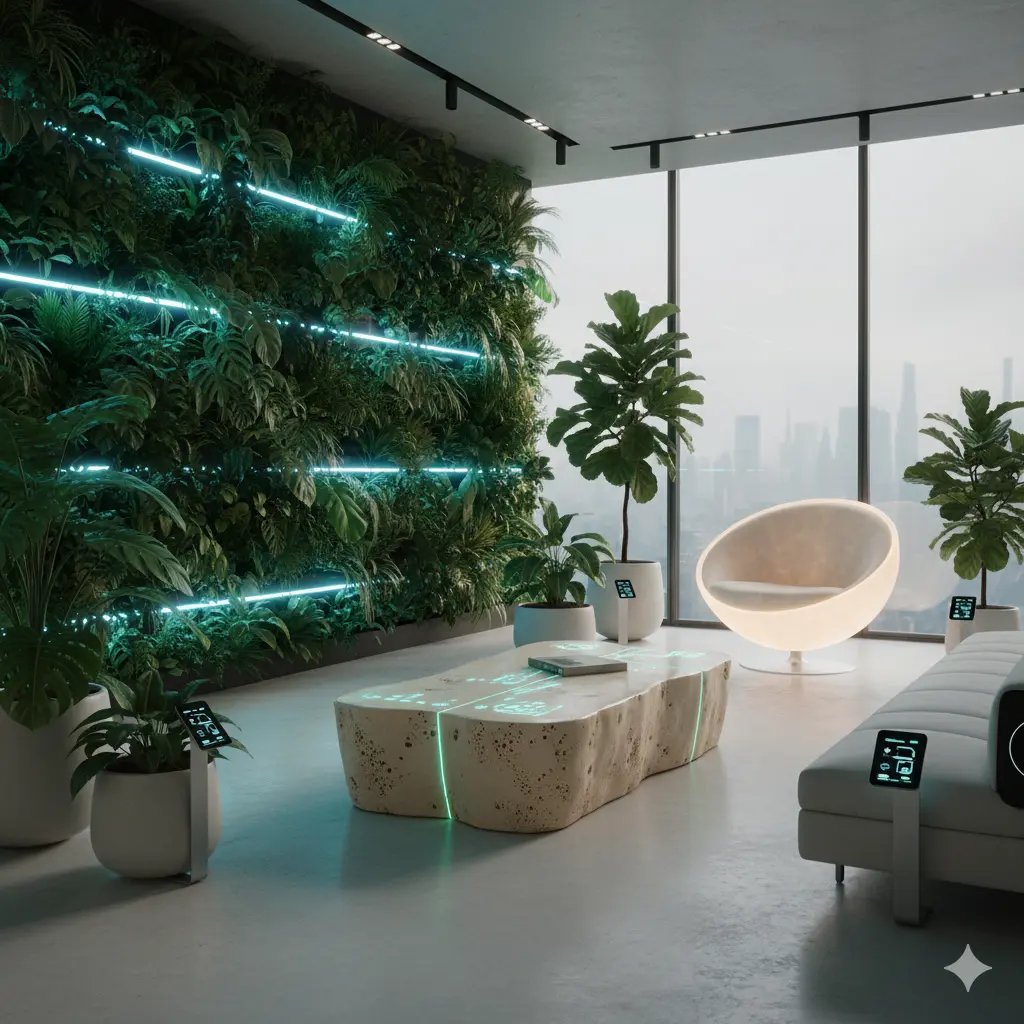
Frequently Asked Questions (FAQs) About Green House Decor
1. What is the best way to start with Green House Decor at home?
Start small and simple to avoid feeling overwhelmed. Begin by identifying one room, like your living room or bedroom. Introduce two or three easy-care, air-purifying plants such as a Snake Plant or a Pothos. Next, swap out one synthetic textile for a natural one—for example, replace a polyester throw pillow with an organic cotton or linen one. Finally, commit to using non-toxic cleaning products in that room. These small, manageable steps build a strong foundation for a deeper Green House Decor journey without requiring a major budget or lifestyle overhaul.
2. How do I decorate my small apartment with eco-friendly Green House Decor ideas?
Small spaces are perfect for Green House Decor! Maximize vertical space by using hanging planters and wall-mounted shelves for your plants, which draws the eye up and makes the room feel larger. Choose multi-functional furniture made from sustainable materials, like a storage ottoman or a sofa bed. Use large mirrors to reflect light and greenery, creating an illusion of depth. Stick to a light, neutral color palette to keep the space feeling airy, and let your plants provide the color. Remember, in a small apartment, every item should be both beautiful and functional.
3. What are the best low-light plants for Green House Decor in a bathroom?
Bathrooms, often low in light but high in humidity, are ideal for certain plants. The Snake Plant is virtually indestructible and tolerates very low light. The ZZ Plant is another tough contender that thrives on neglect. For a softer look, Boston Ferns and Peace Lilies adore the humidity from your shower and will thrive in the indirect light. Spider Plants are also excellent choices, as they are adaptable and their trailing leaves look beautiful on a shelf. Always ensure your bathroom has some natural light, even if it’s just a small window.
4. Is Green House Decor more expensive than conventional decor?
It can be, but it doesn’t have to be. While investment pieces like an organic mattress or a custom reclaimed wood table have a higher upfront cost, the Green House Decor philosophy is ultimately about mindful consumption. You save money by buying less, choosing second-hand, and DIYing. Propagating plants is free, and shopping at thrift stores is often cheaper than buying new, low-quality furniture. Over time, durable, high-quality sustainable items outlast cheap alternatives, saving you money. Think of it as a shift from spending often on disposable items to investing once in lasting quality.
5. How can I tell if a furniture brand is truly sustainable and not just greenwashing?
Look for transparency and third-party certifications. A genuine brand will clearly state their material sources, manufacturing processes, and corporate ethics on their website. Key certifications to look for include FSC for wood, GOTS for textiles, and Greenguard Gold for low emissions. Be wary of vague terms like “eco-friendly” or “all-natural” without specific backing. Research the brand’s reviews and see if they have any sustainability reports. True sustainability is a core part of their story, not just a marketing tagline.
6. Can I have a green bedroom with plants, or will they affect my sleep?
You absolutely can and should have plants in your bedroom! The old myth that plants release harmful CO2 at night is largely overstated. The amount of carbon dioxide produced is negligible and far outweighed by their air-purifying benefits. In fact, plants like Snake Plants and Peace Lilies work around the clock to remove toxins like benzene and formaldehyde from the air, resulting in a cleaner, healthier environment for sleep. Some people even find that the presence of plants has a calming, stress-reducing effect that promotes better rest.
7. What are some easy DIY Green House Decor projects for beginners?
Start with simple, high-impact projects. Macramé plant hangers require only cord and a few basic knots and instantly elevate your plants. Painting terracotta pots with non-toxic paint is a fun way to add color and personality. Creating a propagation station by placing plant cuttings in decorative glass bottles is free and beautiful. Upcycling glass jars into vases or storage containers is another easy win. These projects require minimal skill and investment but offer maximum satisfaction and a personalized touch to your home.
8. How often should I water my indoor plants for Green House Decor?
There is no one-size-fits-all answer, as it depends on the plant type, pot size, light, and season. The golden rule is to always check the soil first. Stick your finger about an inch into the soil. If it feels dry, it’s time to water. If it’s still moist, wait. Most common houseplants prefer to dry out slightly between waterings. Overwatering is the most common cause of death. It’s better to underwater than overwater. Consider using a moisture meter for a more precise reading, especially when you’re just starting out.
9. What is biophilic design and how is it related to Green House Decor?
Biophilic design is the practice of connecting people and nature within our built environments and spaces. Green House Decor is the practical application of biophilic design principles in a residential setting. While biophilia is the theory (incorporating natural light, air, plants, materials, and views), Green House Decor is the actionable practice (choosing that FSC-certified wood table, hanging the plant in the macrame hanger, opening the window for fresh air). They are two sides of the same coin, both aiming to create healthier, more harmonious living spaces by reintegrating nature into our daily lives.
10. Which plants are best for purifying the air in my Green House Decor setup?
According to the NASA Clean Air Study and subsequent research, some of the most effective air-purifying plants are the Areca Palm (a natural humidifier), Lady Palm, Boston Fern, Snake Plant (filters benzene, formaldehyde, trichloroethylene, xylene, and toluene), Peace Lily, and English Ivy (particularly good against mold). For best results, cluster several plants together rather than spreading them out singly. Remember, while plants are excellent at improving air quality, they work best in conjunction with good ventilation and source control (using low-VOC products).
11. How can I make my rental home eco-friendly without making permanent changes?
Renters have immense power to create a green home! Focus on non-permanent changes. Use removable, peel-and-stick wallpaper made from natural fibers. Invest in portable air purifiers and lots of plants. Choose beautiful, sustainable rugs, curtains, and textiles that you can take with you. Use LED floor and table lamps instead of relying on the landlord’s fixtures. Talk to your landlord about switching to a renewable energy provider if possible. Your deposit and your planet will thank you.
12. What are the best sustainable materials to look for in furniture?
Top-tier sustainable materials include reclaimed wood (saves trees and has character), bamboo (rapidly renewable and strong), FSC-certified wood (ensures responsible forestry), rattan and wicker (renewable and lightweight), and cork (harvested without harming the tree). For upholstery, look for GOTS-certified organic cotton, linen, hemp, and Tencel lyocell, which is made from sustainably sourced wood pulp in a closed-loop process that recycles water and solvents.
13. Are there any eco-friendly alternatives to standard paint?
Yes, and they are excellent! Conventional paints release VOCs that harm indoor air quality. Instead, opt for Zero-VOC or Low-VOC paints from brands like Benjamin Moore Natura, Sherwin-Williams Harmony, or Clare Paint. Even better are natural paints made from ingredients like clay, chalk, milk protein (casein), and plant dyes. These natural options are not only non-toxic but are also breathable and come in beautiful, earthy, mineral-based colors that perfectly complement a Green House Decor aesthetic.
14. How do I style plants with my existing decor without it looking messy?
The key to a styled, not messy, look is intentionality. Group plants in odd numbers (3, 5) for a more natural, pleasing arrangement. Use consistent planters in a similar color family or material (e.g., all terracotta, all white ceramic, or all woven baskets) to create cohesion. Vary the heights and textures—place a tall, structural plant in the corner, a trailing one on a shelf, and a bushy one on a table. Use plant stands to elevate them to different levels. This creates a curated, designer look rather than a random collection.
15. What is the number one mistake people make when starting Green House Decor?
The biggest mistake is overcommitting and getting discouraged. People often buy a dozen plants at once without researching their care, leading to a few dying, which feels like a failure. Or they try to replace all their furniture overnight, which is expensive and unsustainable. The correct approach is the opposite: start slowly. Master the care of two or three plants. Make one sustainable swap at a time. Celebrate the small wins. Green House Decor is a marathon, not a sprint—a lifelong journey of learning and growing alongside your home.
Conclusion: Your Journey to a Greener, Cozier Nest Begins Now
Embracing Green House Decor is one of the most rewarding journeys you can undertake for your home and your well-being. It’s a path that leads to a living space that is not only visually stunning but also actively contributes to your health and the health of our planet. We’ve explored everything from the core principles of sustainability and biophilia to the nitty-gritty details of plant care, room-by-room guides, and future trends. Remember, this isn’t about achieving perfection overnight. It’s about making more conscious choices, one plant, one piece of furniture, one habit at a time.
Whether you start by propagating a single Pothos vine, switching to a non-toxic cleaner, or simply opening your windows wider to let the fresh air in, you are taking a meaningful step. Your home is your cozy nest, and by infusing it with the principles of Green House Decor, you are transforming it into a true sanctuary—a place that shelters, nurtures, and inspires you every single day.
We are here to support you every step of the way. For more inspiration, detailed guides, and creative ideas to cultivate the home of your dreams, continue exploring our resources at https://cozynestdecor.pro/. Your greener, more serene, and beautifully sustainable home awaits.New chat